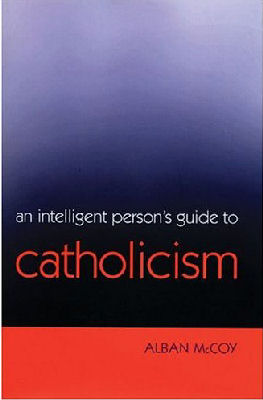
|
Posted August 15, 2006
Book: An Intelligent Person’s Guide to Catholicism Author: Alban McCoy Continuum, New York. 2001. Pp. 138 An Excerpt from the Jacket:
Are Faith and Reason enemies or allies? Do we need proof of God? Can God and Evil both exist? Do we need the Pope? Is annulment divorce by another name? Why are women not ordained as priests in the Catholic Church? In an age where morality is increasingly challenged and reassessed, Alban McCoy demonstrates the relevance of the Catholic Church’s moral teaching to the modern age and shows how Roman Catholicism is fully engaged with the realities of life and the Spirit. An Excerpt from the Book: Property, Poverty and Relationships The concept of property has changed radically in recent times. Consider the fact that the corollary to the commandment about not coveting property is that one should not covet another’s wife. Clearly, the association of these injunctions implies that a man’s wife is his property. And indeed this was the case in the setting and at the time when these commandments were originally given. Or consider that until the end of the last century, stealing another’s property was punishable by transportation to New South Wales in Australia – even if the property in question was a cotton shirt or a morsel of bread. But consider also, in the other direction, how the concept of property has expanded. We uncontroversially think of publications and ideas as intellectual property, and we protect such things by means of trade marks and patents. The possibility of electronic theft and corporate crime has also made us more sensitive to the legitimate claim of ownership whose transgression affects us all in the form of the ever-expanding black economy and tax evasion. Concepts of property and ownership have changed under the influence of a growing sense of interdependence across the globe, both economic and social, and a growing sensitivity to the plight of those chronically deprived of the necessities of life through no fault of their own. Social justice, in other words, has expanded our cherished notions of ownership and property. Now one of the hidden treasures of Catholic doctrine is its social teachings. Its critics may accuse the Church of being preoccupied with sex in its moral theology, but no other Christian body has made a more vital contribution to social teaching in the modern world than the Catholic Church. An interesting and topical example is the Common Market, the forerunner of the European Union. The framework of social theory which inspired Christian democrats in Europe as early as the 1920s to develop a Common Market and European integration, albeit with the prevention of future wars in mind, was taken from the social teaching of the Church. The founding fathers of the Common Market sought to drive a wedge between the individualism of liberals and the collectivism of socialists. One of their key principles was the notion of subsidiarity, which even now informs the workings of the European Union. This is the notion that the person, the family, and the smaller associations, whatever their function and purpose within a framework of just law, should be free of interference from larger associations, especially the state, unless the help of such organizations is needed for them to obtain their legitimate objectives. Catholic social teaching first emerged in the nineteenth century in response to the conditions provoked by the Industrial Revolution. For the first time in human history there was a major civilization based on an industrial economy giving rise to an urbanized people. How was one to provide fair working and living conditions and just financial rewards for the non-property owning majority of wage-earners in towns an cities whose labor contributed vitally to the new wealth-creation process? Pope Leo XIII’s social encyclical Rerum Novarum sought to answer such pressing new questions. Table of Contents: Part I Common Questions Faith and reason: enemies or allies? God and proof: argument or assertion? ‘God’ and God: language or reality? God: three and one? God and evil: can they both exist? The Church: do we need it? Sacraments: saving signs or magic? Our Lady: mariology or mariolatry? The papacy: help or obstacle? Catholicism and conscience: are they compatible? The ordination of women: why not? Annulment: divorce by another name? Christianity and world religions: can they all be true? Part II The Ten Commandments Human flourishing God: not idols, magic or performance Parents: honor them, despite Philip Larkin Value human life – all of it Defend marriage Property, poverty and relationships Say what you mean, and mean what you say Part III The Seven Deadly Sins 1. Pride 2. Sloth 3. Envy 4. Avarice 5. Gluttony 6. Wrath 7. Lust Part IV The Virtuous Life Introducing the virtues Faith Hope Love – and do what you will |
|
